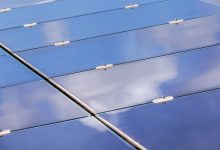Researchers have developed a new method of producing organic solar cells which eliminates the need for potentially toxic materials, while maintaining high conversion efficiencies, in a breakthrough that could unlock the mass manufacturer of next-generation solar cells.
The breakthrough, achieved by a team from the South China University of Technology, has been detailed in a report published in the journal Joule, which detailed how the researchers avoided the need for potentially toxic halogenated solvents in the processing of the materials used in the solar cell production process.
While using the non-toxic alternatives to produce the organic solar cells, the researchers successfully produced an organic solar module with a conversion efficiency of above 14.4 per cent, which ranks amongst the higher-end for organic solar cells.
The use of halogenated solvents in the production process has been a barrier to the mass production of organic solar cells. Halogenated solvents have ideal characteristics for use in the processing of organic solar cells, but the materials can have significant health impacts if not managed properly.
The prospect of large scale use of the halogenated solvents has been a concern within the solar industry, and research has focused on the development of non-toxic, ‘green-solvent’ alternatives that can be used in organic solar cell fabrication.
Researchers, based at the State Key Laboratory of Luminescent Materials and Devices, have successfully produced high-efficiency organic solar cells without the use of halogenated solvents, using a non-toxic ‘non-fullerene acceptor’ as an alternative material and a ‘side-chain engineering’ technique.
“Recently, [organic solar cells (OSCs)] have made great progress in the power conversion efficiency (PCE). However, most of these OSCs are fabricated with small-area devices from highly toxic organic solvents by spin-coating in an inert atmosphere, which shows low compatibility with mass production,” the research paper says.
“This work indicates that the side-chain engineering is an effective strategy to approach non-fullerene acceptors for non-halogen solvent-processed highly efficient large-area modules.”
Organic solar cells have emerged as a possible alternative to silicon-based solar cells, having the potential to be produced at a lower cost, and the ability to be embedded in a wider range of materials and surfaces.
As organic solar cells operate using semiconductor materials produced through chemical processes, rather than being built upon stiff and fragile silicon wafers, organic solar cells can be integrated flexible or curved surfaces, including buildings and vehicles.
However, to date, organic solar cells have achieved lower conversion efficiencies compared to silicon based solar cells, and their deployment has been limited to niche applications and have suffered from longer-term performance degradation issues. According to Fraunhofer ISE, silicon based solar cells still command around 95 per cent of the total solar market.
Most commercially available organic solar cells achieve a conversion efficiency of around 10 per cent, considerably lower than the efficiencies of silicon based solar cells, which are now generally above 20 per cent.
Having identified an alternative to toxic solvents normally used in the production of organic solar cells, researchers believe the breakthrough could open up the potential for commercial-scale production of organic solar cells, which will drive down costs and incentivise further work towards efficiency improvements.
Organic solar cells are often paired with silicon cells, using a layering process that produces ‘tandem’ cells, where the two different types of solar cell technologies are literally layered on top of one another. As the two technologies can absorb different parts of the solar spectrum and convert it into electricity, higher conversion efficiencies can be achieved.
Earlier in the year, researchers from the Australian National University set a new conversion efficiency world record for tandem solar cells, combining a traditional silicon solar cell with a perovskite solar cell, achieving a conversion efficiency of 27.7 per cent.










